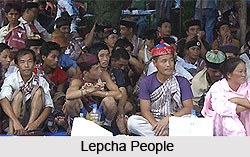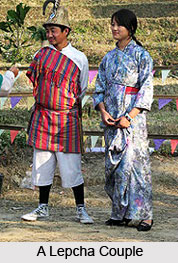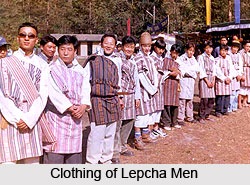 The Lepcha population is concentrated in the central part of Sikkim. This is the area that encompasses the confluence of Lachen and Lachung rivers and Dickchu. The terrain here is rugged and Lepcha dwellings are perched precariously on the steep hillsides. No wonder the word "Lepcha" means the Ravine folk. They mostly live on agriculture of paddy, cardamom and oranges. The Lepchas speak their own language called "Lepcha".
The Lepcha population is concentrated in the central part of Sikkim. This is the area that encompasses the confluence of Lachen and Lachung rivers and Dickchu. The terrain here is rugged and Lepcha dwellings are perched precariously on the steep hillsides. No wonder the word "Lepcha" means the Ravine folk. They mostly live on agriculture of paddy, cardamom and oranges. The Lepchas speak their own language called "Lepcha".
Origin of Lepchas
The origin of the Lepcha is unknown. It is guessed that they might have originated in Myanmar, Tibet or Mongolia. However, the Lepcha people themselves firmly believe that they did not migrate to the current location from anywhere. They believe that they are indigenous to the region.
Communities of Lepchas
The Lepchas are divided into four communities namely the Renjongmu of Sikkim; the Tamsangmu of Kalimpong, Kurseong and Mirik; the Ilammu of Ilam district, Nepal and the Promu of Samtse and Chukha in Southwestern Bhutan. In India, they are also spread over Darjeeling and in the hills of West Bengal.
Religious Beliefs of Lepchas
The Lepchas are predominantly Buddhists but many of them are also Christians having been converted to this faith by the missionaries.
Before adopting Buddhism or Christianity as their religion, the earliest Lepcha settlers were believers in the Bon faith or Mune faith.
 This faith was basically based on spirits, good and bad. Witchcraft and exorcism were very common. They worshipped spirits of mountains, rivers and forests which was but natural for a tribe that co-existed so harmoniously with the rich natural surroundings. The well-known deities of the Lepchas are Itbumoo, Rom, Itbu Debu Rom, Kongchen Konglo and Tamsang Thing, who is also said to have invented the Lepcha script. The Lepcha priests are known as Bomthing and they perform intricate ceremonies to invoke the blessings of the spirits.
This faith was basically based on spirits, good and bad. Witchcraft and exorcism were very common. They worshipped spirits of mountains, rivers and forests which was but natural for a tribe that co-existed so harmoniously with the rich natural surroundings. The well-known deities of the Lepchas are Itbumoo, Rom, Itbu Debu Rom, Kongchen Konglo and Tamsang Thing, who is also said to have invented the Lepcha script. The Lepcha priests are known as Bomthing and they perform intricate ceremonies to invoke the blessings of the spirits.
Clothing of Lepchas
Traditionally, the Lepcha women wear ankle-length dumdem, also called dumdyam paired with a contrasting long-sleeved blouse. Dumdem is one large piece designed using smooth cotton or silk, usually of a solid colour. The men wear dumpra which is a multicolored, hand-woven cloth pinned at one shoulder and held in place by a waistband. Dumpra is usually worn over a white shirt and trousers. The men also wear a flat round cap called a thyaktuk.
Marriage Customs of Lepchas
In the Lepcha community, the marriage is negotiated between the families of the bride and the groom. If everything goes fine between both the families then the lama checks the horoscopes of the boy and girl to schedule a favourable date for the wedding. According to their custom, the wedding takes place at noon on the auspicious day.
Festival of Lepchas
One major festival of the Lepchas is the Namsoong which marks the beginning of the New Year. A highlight of this festival is the week long mela or fair held at Namprikdam at the confluence of Tista and Tolung-chu near Mangan in North Sikkim.

Legends of Lepchas
The Lepcha or Dzongu folklore is rich with stories. One of the very popular stories has a parallel with the legend of the "Tower of Babel". It describes that the Rongs or Lepchas once attempted to ascend to Rum or Heaven by building a tower of earthen pots. When Rum was about to be reached, God thought he must put an end to this venture. He made them speak in different tongues with the intention of creating confusion. The man at the top of the tower shouted "Kok vim yang tale" i.e. Pass the pole with the hook but the men at the bottom heard the words "Chek tala" i.e. cut it down. The tower was hacked down and its remains are still found in Daramdin near Sombaria in Western Sikkim.
The Government feels protective towards the Lepchas, believing that they represent a conservative force. They are a balance wheel which helps save a way of life from being overwhelmed by Western culture.






